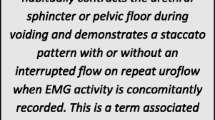Abstract
The combined effect of isopropamide 5 mg plus trifluoperazine 1 mg (a combined anticholinergic and alpha-adrenergic antagonist) (Smith, Kline and French Canada Ltd, Ontario, Canada), antibiotics, and bladder drill was retrospectively assessed on 100 consecutive women, aged 16 to 47 years, presenting with the signs and symptoms of the urethral syndrome. Assessment included history, physical examination, routine bacterial and chlamydial cultures (cervical, urethral, vaginal, and urine), cystourethroscopy, and urodynamics. Urodynamic diagnoses included detrusor sphincter dyssynergia (n=84), detrusor instability (n =8), external urethral sphincter spasticity (n=4), and sensory urgency (n=1). Three patients with positive urine cultures were excluded. Urethrotrigonitis was visualized at cystourethroscopy in all patients. Only one case of chlamydial urethritis-cervicitis was identified by culture: 82% of patients had a history of prior antibiotic therapy for lower urinary tract symptoms and 21% were being treated with antibiotics at the time of their initial assessment.
Following 1 month of treatment, 44 (45%) patients were cured of all symptoms, 49 (51%) were improved, 3 (3%) were unchanged and 1 (1%) was worse. Significant changes in uroflowmetry included a reduction in postvoid residual urine volume from 49 ± 28 ml to 14 ±21 ml (P=0.029) in the unstable bladder group and a conversion from intermittent to continuous uroflow patterns in the detrusor sphincter dyssynergia group (P <0.005, χ2) and overall (P <0.005, χ2). A statistically significant number of patients (P <0.025, χ2) converted from increased to normal tracings on repeat perianal electromyography, suggesting that the pathophysiology of the urethral syndrome is urethral spasticity related to urethral inflammation rather than actual infection.
We conclude that detrusor sphincter dyssynergia, bladder instability, and urethral sphincter spasticity are the common urodynamic findings in the urethral syndrome. A combination of anticholinergic and alpha blocking agent, antibiotics, and a bladder drill markedly improved (96%) symptoms in women with the urethral syndrome.
Similar content being viewed by others
References
Scotti RJ, Ostergard DR. Urethral syndrome. In: Ostergard DR, ed. Gynecological urology and urodynamics — theory and practice, 2nd edn. Baltimore: Williams & Wilkins, 1985:299–321
Schmidt RA. The urethral syndrome. Clin Obstet Gynecol 1985; 12(2):477–485
Raz S, Smith RB. External sphincter spasticity syndrome in female patients. J Urol 1976; 115:443–446
Tanagho EA, Miller ER, Lyon RP, Fisher R. Spastic striated external sphincter and urinary tract infection in girls. Br J Urol 1971; 43:69–82
Curran JW. Gonorrhea and the urethral syndrome. Sex Transm Dis 1977; 4:119–121
Papapetropoulou M, Pappas A. The acute urethral syndrome in routine practice. J Infect 1987; 14:113–118
Brooks, D, Maudar A. Pathogenesis of the urethral syndrome in women and its diagnosis in general practice. Lancet 1972; II:893–898
Stamm WE, Wagner KF, Amsel R, et al. Causes of the acute urethral syndrome in women. N Engl J Med 1980; 303(8):409–415
Tait A, Rees E, Jameson RM. Urethral syndrome associated with chlamydial infection of the urethral and cervix. Br J Urol 1978; 50:425
Fritz H. On the relation of genital to urinary tract infections — diagnostic problems. In: Danielsson D, Juhlin L, Mardh P-A, eds. Genital infections and their complications. Stockholm: Almquist & Wilksell International 1975:193–199
Barbalias GA, Meares EM Jr. Female urethral syndrome: clinical and urodynamic perspectives. Urology 1984; 23(2):208–212
O'Grady FW, Richards B, McSherry MA, O'Farrell SM, Cattell WR. Introital enterobacteria, urinary infection, and the urethral syndrome. Lancet 1970; II:1208–1210
Khanna OP. Disorders of micturition: neuropharmacologic basis and results of drug therapy. Urology 1976; 8(4):316–328
Bates P, Bradley WE, Glen E, et al. Fourth report on the standardization of terminology of lower urinary tract function. Urology 1981; 17:618–620
Gillespie WA, Henderson EP, Linton KB, Smith PJB. Microbiology of the urethral (frequency and dysurial) syndrome. A controlled study with 5-year review. Br J Urol 1989; 64:270–274
Hamilton-Miller JMT, Beumft W, Smith GW. Are fastidious organisms an important cause of dysuria and frequency? The case against microbial diseases. In: Asscher AW, Brumfit W, eds. Nephrology. London: John Wiley, 1986:19–30
Tait J, Peddie BA, Bailey RR, et al. Urethral syndrome (abacterial cystitis) — search for a pathogen. Br J Urol 1985; 57:552–556
Kulseng-Hanssen S, Kristoffersen N. Prevelance and pattern of unstable urethral pressure in one hundred seventy-four gynecologic patients referred for urodynamic investigation. Am J Obstet Gynecol 1983; 146:895–900
Weil A, Milege B, Rottenberg R, et al. Clinical significance of urethral instability. Obstet Gynecol 1986; 68:106–110
Versi E, Cardozo L, Studd J, et al. Evaluation of urethral pressure profilometry for the diagnosis of genuine stress incontinence. World J Urol 1986; 4:4–9
Gerstenberg TC, Lykkegard M, Lindenberg J. Spastic Striated external sphincter syndrome imitating recurrent urinary tract infection in females. Eur Urol 1983; 9:87–92
Kaplan WE, Firlit CF, Schoenberg HW. The female urethral syndrome: external sphincter spasm as etiology. J Urol 1980; 124:48–49
Boyd W. Inflammation. In: Textbook of pathology, 7th edn. Philadelphia: Lea & Febiger, 1964:34
Brubaker LT, Sand PK. Urinary frequency and urgency. Obstet Gynecol Clin North Am 1989; 16:883–896
Bent AE. Etiology and management of detrusor instability. Obstet Gynecol Clin North Am 1989; 16:853–868
Drutz HP. Pharmacology of the lower urinary tract. Can Fam Physician 1987; 33:2569–2572
Author information
Authors and Affiliations
Rights and permissions
About this article
Cite this article
Drutz, H.P., Mainprize, T.C., Tremblay, P. et al. Detrusor sphincter dyssynergia, detrusor instability, and urethral sphincter spasticity as the urodynamic findings in the urethral syndrome: Role of treatment with a combined anticholinergic and alpha blocking agent, bladder drill, and antibiotics. Int Urogynecol J 2, 10–15 (1991). https://doi.org/10.1007/BF00400034
Issue Date:
DOI: https://doi.org/10.1007/BF00400034




